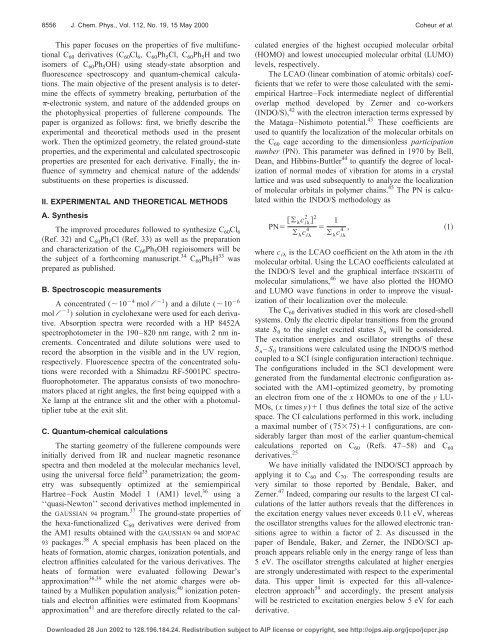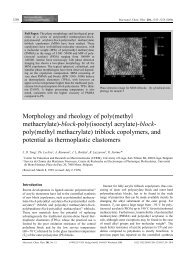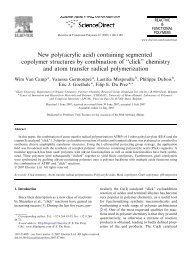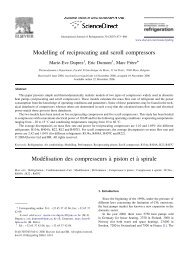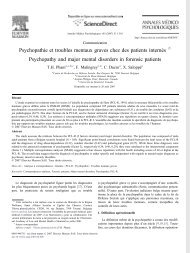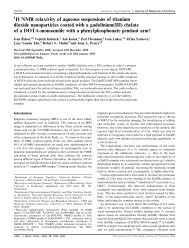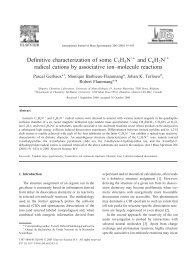Using JCP format - Université de Mons
Using JCP format - Université de Mons
Using JCP format - Université de Mons
Create successful ePaper yourself
Turn your PDF publications into a flip-book with our unique Google optimized e-Paper software.
8556 J. Chem. Phys., Vol. 112, No. 19, 15 May 2000 Coheur et al.<br />
This paper focuses on the properties of five multifunctional<br />
C 60 <strong>de</strong>rivatives C 60 Cl 6 ,C 60 Ph 5 Cl, C 60 Ph 5 H and two<br />
isomers of C 60 Ph 5 OH using steady-state absorption and<br />
fluorescence spectroscopy and quantum-chemical calculations.<br />
The main objective of the present analysis is to <strong>de</strong>termine<br />
the effects of symmetry breaking, perturbation of the<br />
-electronic system, and nature of the ad<strong>de</strong>n<strong>de</strong>d groups on<br />
the photophysical properties of fullerene compounds. The<br />
paper is organized as follows: first, we briefly <strong>de</strong>scribe the<br />
experimental and theoretical methods used in the present<br />
work. Then the optimized geometry, the related ground-state<br />
properties, and the experimental and calculated spectroscopic<br />
properties are presented for each <strong>de</strong>rivative. Finally, the influence<br />
of symmetry and chemical nature of the ad<strong>de</strong>nds/<br />
substituents on these properties is discussed.<br />
II. EXPERIMENTAL AND THEORETICAL METHODS<br />
A. Synthesis<br />
The improved procedures followed to synthesize C 60 Cl 6<br />
Ref. 32 and C 60 Ph 5 Cl Ref. 33 as well as the preparation<br />
and characterization of the C 60 Ph 5 OH regioisomers will be<br />
the subject of a forthcoming manuscript. 34 C 60 Ph 5 H 33 was<br />
prepared as published.<br />
B. Spectroscopic measurements<br />
A concentrated (10 4 mol l 1 ) and a dilute (10 6<br />
mol l 1 ) solution in cyclohexane were used for each <strong>de</strong>rivative.<br />
Absorption spectra were recor<strong>de</strong>d with a HP 8452A<br />
spectrophotometer in the 190–820 nm range, with 2 nm increments.<br />
Concentrated and dilute solutions were used to<br />
record the absorption in the visible and in the UV region,<br />
respectively. Fluorescence spectra of the concentrated solutions<br />
were recor<strong>de</strong>d with a Shimadzu RF-5001PC spectrofluorophotometer.<br />
The apparatus consists of two monochromators<br />
placed at right angles, the first being equipped with a<br />
Xe lamp at the entrance slit and the other with a photomultiplier<br />
tube at the exit slit.<br />
C. Quantum-chemical calculations<br />
The starting geometry of the fullerene compounds were<br />
initially <strong>de</strong>rived from IR and nuclear magnetic resonance<br />
spectra and then mo<strong>de</strong>led at the molecular mechanics level,<br />
using the universal force field 35 parametrization; the geometry<br />
was subsequently optimized at the semiempirical<br />
Hartree–Fock Austin Mo<strong>de</strong>l 1 AM1 level, 36 using a<br />
‘‘quasi-Newton’’ second <strong>de</strong>rivatives method implemented in<br />
the GAUSSIAN 94 program. 37 The ground-state properties of<br />
the hexa-functionalized C 60 <strong>de</strong>rivatives were <strong>de</strong>rived from<br />
the AM1 results obtained with the GAUSSIAN 94 and MOPAC<br />
93 packages. 38 A special emphasis has been placed on the<br />
heats of <strong>format</strong>ion, atomic charges, ionization potentials, and<br />
electron affinities calculated for the various <strong>de</strong>rivatives. The<br />
heats of <strong>format</strong>ion were evaluated following Dewar’s<br />
approximation 36,39 while the net atomic charges were obtained<br />
by a Mulliken population analysis; 40 ionization potentials<br />
and electron affinities were estimated from Koopmans’<br />
approximation 41 and are therefore directly related to the calculated<br />
energies of the highest occupied molecular orbital<br />
HOMO and lowest unoccupied molecular orbital LUMO<br />
levels, respectively.<br />
The LCAO linear combination of atomic orbitals coefficients<br />
that we refer to were those calculated with the semiempirical<br />
Hartree–Fock intermediate neglect of differential<br />
overlap method <strong>de</strong>veloped by Zerner and co-workers<br />
INDO/S, 42 with the electron interaction terms expressed by<br />
the Mataga–Nishimoto potential. 43 These coefficients are<br />
used to quantify the localization of the molecular orbitals on<br />
the C 60 cage according to the dimensionless participation<br />
number PN. This parameter was <strong>de</strong>fined in 1970 by Bell,<br />
Dean, and Hibbins-Buttler 44 to quantify the <strong>de</strong>gree of localization<br />
of normal mo<strong>de</strong>s of vibration for atoms in a crystal<br />
lattice and was used subsequently to analyze the localization<br />
of molecular orbitals in polymer chains. 45 The PN is calculated<br />
within the INDO/S methodology as<br />
PN c 2 i 2<br />
4 1<br />
4 , 1<br />
c i c i<br />
where c i is the LCAO coefficient on the th atom in the ith<br />
molecular orbital. <strong>Using</strong> the LCAO coefficients calculated at<br />
the INDO/S level and the graphical interface INSIGHTII of<br />
molecular simulations, 46 we have also plotted the HOMO<br />
and LUMO wave functions in or<strong>de</strong>r to improve the visualization<br />
of their localization over the molecule.<br />
The C 60 <strong>de</strong>rivatives studied in this work are closed-shell<br />
systems. Only the electric dipolar transitions from the ground<br />
state S 0 to the singlet excited states S n will be consi<strong>de</strong>red.<br />
The excitation energies and oscillator strengths of these<br />
S n – S 0 transitions were calculated using the INDO/S method<br />
coupled to a SCI single configuration interaction technique.<br />
The configurations inclu<strong>de</strong>d in the SCI <strong>de</strong>velopment were<br />
generated from the fundamental electronic configuration associated<br />
with the AM1-optimized geometry, by promoting<br />
an electron from one of the x HOMOs to one of the y LU-<br />
MOs, (x times y)1 thus <strong>de</strong>fines the total size of the active<br />
space. The CI calculations performed in this work, including<br />
a maximal number of (7575)1 configurations, are consi<strong>de</strong>rably<br />
larger than most of the earlier quantum-chemical<br />
calculations reported on C 60 Refs. 47–58 and C 60<br />
<strong>de</strong>rivatives. 25<br />
We have initially validated the INDO/SCI approach by<br />
applying it to C 60 and C 70 . The corresponding results are<br />
very similar to those reported by Bendale, Baker, and<br />
Zerner. 47 In<strong>de</strong>ed, comparing our results to the largest CI calculations<br />
of the latter authors reveals that the differences in<br />
the excitation energy values never exceeds 0.11 eV, whereas<br />
the oscillator strengths values for the allowed electronic transitions<br />
agree to within a factor of 2. As discussed in the<br />
paper of Bendale, Baker, and Zerner, the INDO/SCI approach<br />
appears reliable only in the energy range of less than<br />
5 eV. The oscillator strengths calculated at higher energies<br />
are strongly un<strong>de</strong>restimated with respect to the experimental<br />
data. This upper limit is expected for this all-valenceelectron<br />
approach 59 and accordingly, the present analysis<br />
will be restricted to excitation energies below 5 eV for each<br />
<strong>de</strong>rivative.<br />
Downloa<strong>de</strong>d 28 Jun 2002 to 128.196.184.24. Redistribution subject to AIP license or copyright, see http://ojps.aip.org/jcpo/jcpcr.jsp


